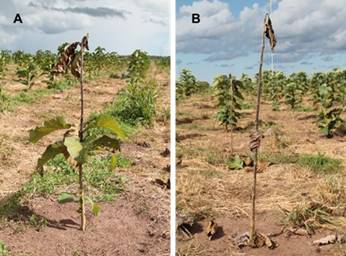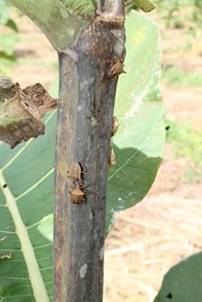Sección agrícola
First report of Euschistus heros (Hemiptera: Pentatomidae) damaging teak trees (Tectona grandis) in the neotropics
Primer registro del ataque de Euschistus heros (Hemiptera: Pentatomidae) en árboles de teca (Tectona grandis) en el neotrópico
1 Forest Engineering student, Phytosanitary Laboratory (FitLab), Federal Institute of Mato Grosso (IFMT), Cáceres, Mato Grosso, Brazil, jeffersoney.garcia@gmail.com.
2 Forest Engineer, Master student, Department of Entomology / BIOAGRO, Federal University of Viçosa, Viçosa, Minas Gerais, Brazil, leonardolfialho@gmail.com.
3 Forest Engineer, Ph. D., Volunteer researcher, Phytosanitary Laboratory (FitLab), Federal Institute of Mato Grosso (IFMT), Cáceres, Mato Grosso, Brazil, isabelcarolinadelima@gmail.com.
4 Forest Engineer, Ph. D., Professor, Department of Entomology, Federal University of Lavras, Lavras, Minas Gerais, Brazil, zanetti@ufla.br.
5 Forest Engineer, Ph. D., Professor, Phytosanitary Laboratory (FitLab), Federal Institute of Mato Grosso (IFMT), Cáceres, Mato Grosso, Brazil, alexandre.santos@cas.ifmt.edu.br.
Abstract
Teak, Tectona grandis is one of the most valuable woods in the world. In Brazil, it is attacked by sap-sucking insects such as Euschistus heros, known as Neotropical brown stink bug. Here we report the first occurrence of this pest in teak tree plantations in Cáceres, Mato Grosso, Brazil. The injuries on the trees were characterized and photographed, along with the insects collected on plants. Injuries caused the apical bud to dry, advancing to the entire plant drying. Injuries occur from the histological damage caused by insect stylets and the toxic enzyme released into plant cells
Keywords: Forest entomology; insect damage; neotropical brown stink bug; teak; Euschistus heros; Hemiptera; Pentatomidae
Resumen
La teca, Tectona grandis es una de las maderas más valiosas del mundo. En Brasil es atacado por insectos plaga chupadores de savia. Entre ellos se encuentra Euschistus heros conocido como chinche de la soya. Este trabajo tuvo como objetivo registrar, por primera vez, la aparición de esta plaga en plantaciones de árboles de teca en Cáceres, Mato Grosso, Brasil. Las lesiones causadas por E. heros en los árboles se caracterizaron y fotografiaron. Los insectos se recolectaron en las plantas. Las lesiones causaron el secado del brote apical, avanzando al secado total de la planta. Estas lesiones se producen por el daño histológico causado por el estilete de insecto y la enzima tóxica liberada en las células vegetales.
Palabras clave: Entomología forestal; daño de insectos; chinche de la soya; teca; Euschistus heros; Hemiptera; Pentatomidae
Introduction
Sustainable production of timber and non-timber products from planted forests of exotic origin, such as Eucalyptus spp. (Myrtaceae) and Pinus spp. (Pinaceae) are sources of wealth and employment. Tectona grandis L. (Lamiaceae), known as teak, is also one of the most important species and concentrates a considerable part of its plantations in Mato Grosso state, Brazil. It was introduced commercially in the country in the municipality of Cáceres, in the decade of 1960 (Rosa et al. 2017). Tectona grandis is a species from tropical forests of Southeast Asia, specifically India, Myanmar, Thailand and Laos, areas with remarkable climatic variations. This demonstrates the high adaptability of this species to diverse environments, being a great investment opportunity in Brazil due to its adaptation to the edaphoclimatic conditions in several regions (Paes et al. 2014).Homogeneous teak plantations can be infested by various types of pests of economic importance, such as the sap-sucking insects Nezara viridula Linnaeus, 1758, Edessa meditabunda (Fabricius, 1794), Piezodorus guildinii (Westwood, 1837) and Maconellicoccus hirsutus (Green, 1908), which cause relevant economic losses (Nascimento et al. 2016).This note aims to report the first occurrence of the Neotropical brown stink bug, Euschistus heros (F.), damaging commercial plantations of Tectona grandis located in Cáceres, Mato Grosso state, Brazil.
Materials and methods
The insect infestation was detected in December 2018, in the municipality of Cáceres (57º40’51”W 16º11’42”S and altitude of 117 m), Mato Grosso state, Brazil. The injuries in leaves and apical buds on the T. grandis trees were inspected and photographed, and bug specimens feeding on damaged tissues were collected in 63 random plants samples using an entomological net. Adult insects were collected and preserved in 70 % alcohol for identification. Voucher specimens were deposited in the Forest Protection Collection of the Phytosanitary Laboratory of the Federal Institute of Mato Grosso - Campus in Cáceres.
Results and discussion
The specimens were identified as Euschistus heros. The insects were detected in a 10 - 94 months-year-old clonal teak commercial stand, planted at 4 x 4 m spacing in 10 ha (Fig. 1). In this stand, the insects suck the plants and promote the drying of the apical or terminal bud (Fig. 2A), which soon evolved to a total drought of the plants (Fig. 2B ). Stink bugs (Pentatomidae) inject enzymes present in their saliva. These enzymes fuse and dissolve the protein body of plant cells (Depieri and Panizzi 2011), which may explain the drying of teak plants. The morphology of their stylet and the biochemical characteristics of the enzyme present in their saliva causes histological damage and physiological and biochemical disorders to the cells in grains (Depieri and Panizzi 2011).
Euschistus heros is a polyphagous species that feed on a variety of crops of economic importance. It is one of the main economic pests for soybean cultivation in Brazil and may reach a density of 40 - 60 individuals per m-1 during the harvest (Soza-Gómez and Silva 2010; Roza-Gomes et al. 2011; Paes et al. 2014; Husch et al. 2018). After harvesting, the bug feeds on alternate hosts (Ribeiro et al. 2016), which may explain its dispersion to the teak plants.
Acknowledgements
To “Pró-reitoria de Pesquisa, Pós-Graduação e Inovação (PROPES) do Instituto Federal de Educação, Ciência e Tecnologia de Mato Grosso (IFMT)” for research funding support. To Prof. Jocelia Grazia from the Department of Zoology, Federal University of Rio Grande do Sul, for the identification of the specimens.
Literature cited
DEPIERI, R. A.; PANIZZI, A. R. 2011. Duration of feeding and damage to soybean seed by stink bugs. Neotropical Entomology 40 (2): 197-203. https://doi.org/10.1590/S1519-566X2011000200007
[ Links ]
HUSCH, P. E.; FERREIRA, D. G.; SERAPHIM, N.; HARVEY, N.; SILVA-BRANDÃO, K. L.; SOFIA, S. H.; SOSA-GÓMEZ, D. R. 2018. Structure and genetic variation among populations of Euschistus heros from different geographic regions in Brazil. Entomologia Experimentalis et Applicata 166 (3): 191-203. https://doi.org/10.1111/eea.12666
[ Links ]
NASCIMENTO, D. A.; ANUNCIAÇÃO-Jr, R. M.; ARNHOLD, A.; FERRAZ-FILHO, A. C.; SANTOS, A.; ZANUNCIO, J. C. 2016. Expert system for identification of economically important insect pests in commercial teak plantations. Computers and Electronics in Agriculture 121: 368-373. https://doi.org/10.1016/j.compag.2015.12.024
[ Links ]
PAES, J. B.; LOIOLA, P. L.; CAPELINI, W. A.; SANTOS, L. L.; SANTOS JUNIOR, H. J. G. 2014. Entomofauna associada a povoamentos de teca localizados no sul do Estado do Espírito Santo. Pesquisa Florestal Brasileira 34 (78): 125-132. https://doi.org/10.4336/2014.pfb.34.78.675
[ Links ]
RIBEIRO, F. C.; ROCHA, F. S.; ERASMO, E. A. L. MATOS, E. P.; COSTA, S. J. 2016. Manejo com inseticidas visando o controle de percevejo marrom na soja intacta. Revista de Agricultura Neotropical 3 (2): 48-53. https://doi.org/10.32404/rean.v3i2.1132
[ Links ]
ROSA, T. F. D.; SCARAMUZZA, W. L. M. P.; FEITOSA, I. P.; ABREU, F. F. M. 2017. Produção e decomposição de serapilheira em povoamentos de teca no estado de Mato Grosso, Brasil. Ciência Florestal 27 (4): 1117-1127. https://doi.org/10.5902/1980509830288
[ Links ]
ROZA-GOMES, M. F.; SALVADORI, J. R.; PEREIRA, P. R. V. S.; PANIZZI, A. R. 2011. Injuries of four species of stink bugs to corn seedlings. Ciência Rural 41 (7): 1115-1119. https://doi.org/10.1590/S0103-84782011005000081
[ Links ]
SOZA-GÓMEZ, D. R.; SILVA, J. J. 2010. Neotropical brown stink bug (Euschistus heros) resistance to methamidophos in Paraná, Brazil. Pesquisa Agropecuária Brasileira 45 (7): 767-769. https://doi.org/10.1590/S0100-204X2010000700019
[ Links ]

















